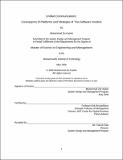Unified communications : convergence of platforms and strategies of two software vendors
Author(s)
Hydari, Muhammad Zia
DownloadFull printable version (2.569Mb)
Alternative title
Convergence of platforms and strategies of two software vendors
Other Contributors
System Design and Management Program.
Advisor
Erik Brynjolfsson.
Terms of use
Metadata
Show full item recordAbstract
Unified Communications: Convergence of Platforms and Strategies of Two Software Vendors by Muhammad Zia Hydari ABSTRACT Unified communication (UC) is the convergence of various modes of communication - voice telephony, email, instant messaging (IM), video conferencing and so on - used by enterprise workers. Academic literature exists that discusses digital convergence in various domains. Although UC has received considerable attention in the business press, we are not aware of any academic study within the domain of UC that explains the convergence of platforms and its links to the technology strategy of UC firms. This thesis presents an academic analysis of some platforms underlying UC and the emerging strategies of two software firms within the UC market. The theory of network effects originally developed by Rohlfs is central to the analysis in this thesis. The analysis of platform strategies of the UC firms is informed by the theoretical work on platform leadership (Gawer & Cusumano), convergence (Greenstein et al.), platform envelopment (Eisenmann et al.), and two-sided platforms (Tirole et al.). The thesis first describes four platform applications underlying UC viz. voice telephony, email, IM, and video communication. The analysis of email, IM and video communication in this thesis is unique as it takes a long term view to explain the current market situation within these domains. In particular, the thesis describes technological factors, network effects, standard battles, and competition that have led to the current market state. The thesis also links insights from these platforms to repercussions for UC supplier firms. The thesis then describes the strategies of two software vendors - Microsoft and IBM - using elements from Gawer & Cusumano's work on platform leadership. (cont.) Microsoft has defined a broad scope of innovation for its converged UC platform requiring it to enter the voice telephony market. The thesis posits that Microsoft's strategy for success is platform envelopment i.e. Microsoft is using shared components and installed user base from its email and IM platforms to create a multi-platform bundle and compete with entrenched platforms in the voice market. The thesis argues that IBM's choice for a narrower platform scope stems from its inferior market position in the email and IM markets as well as scope differences (vis-a-vis Microsoft). Convergence has created system integration opportunities that IBM's services unit has targeted. The thesis describes the implications of IBM's decisions on its ecosystem.
Description
Thesis (S.M.)--Massachusetts Institute of Technology, System Design and Management Program, 2008. This electronic version was submitted by the student author. The certified thesis is available in the Institute Archives and Special Collections. Includes bibliographical references (p. 145-157).
Date issued
2008Department
System Design and Management Program.Publisher
Massachusetts Institute of Technology
Keywords
System Design and Management Program.